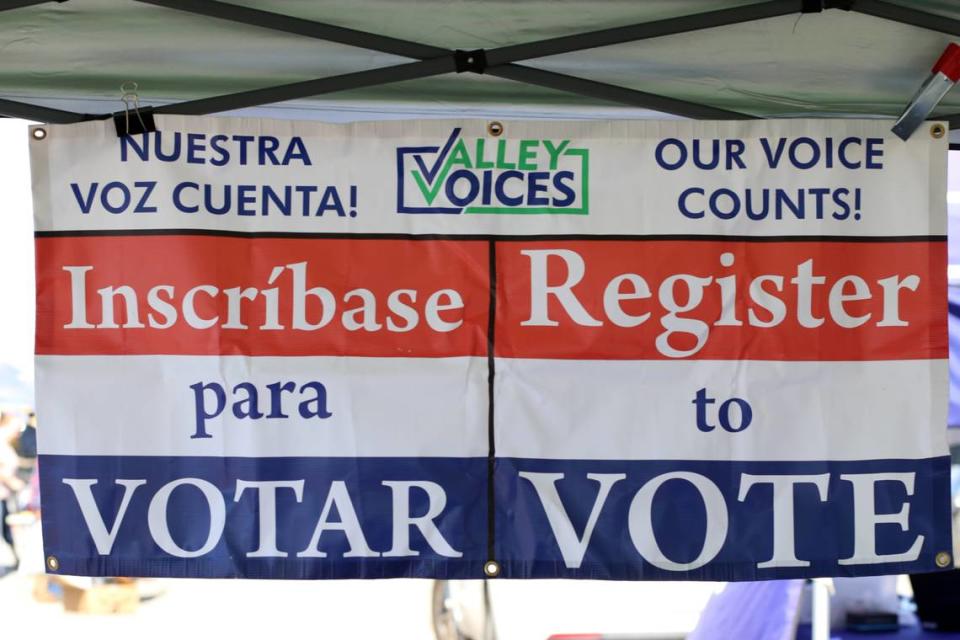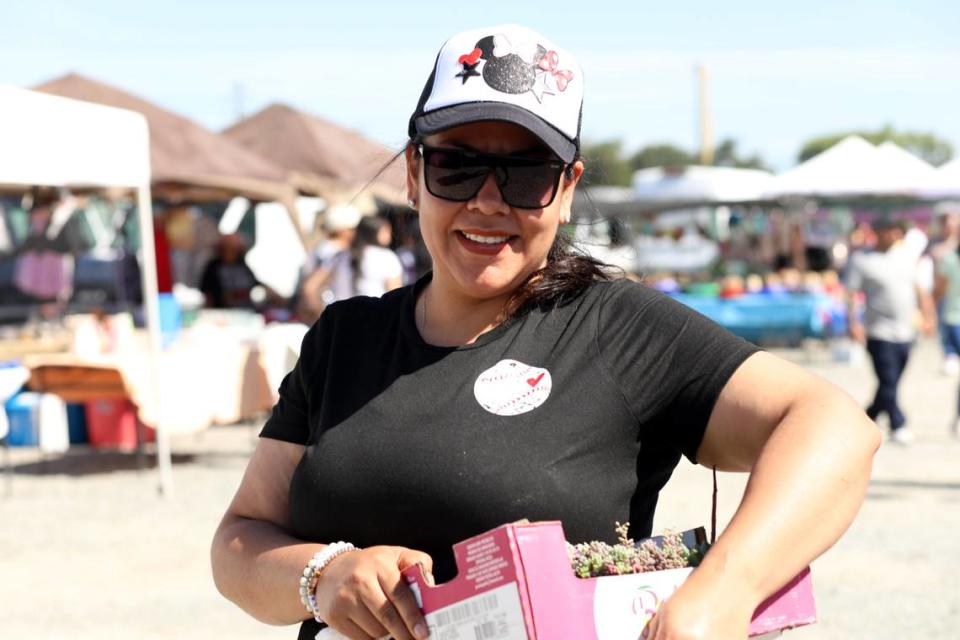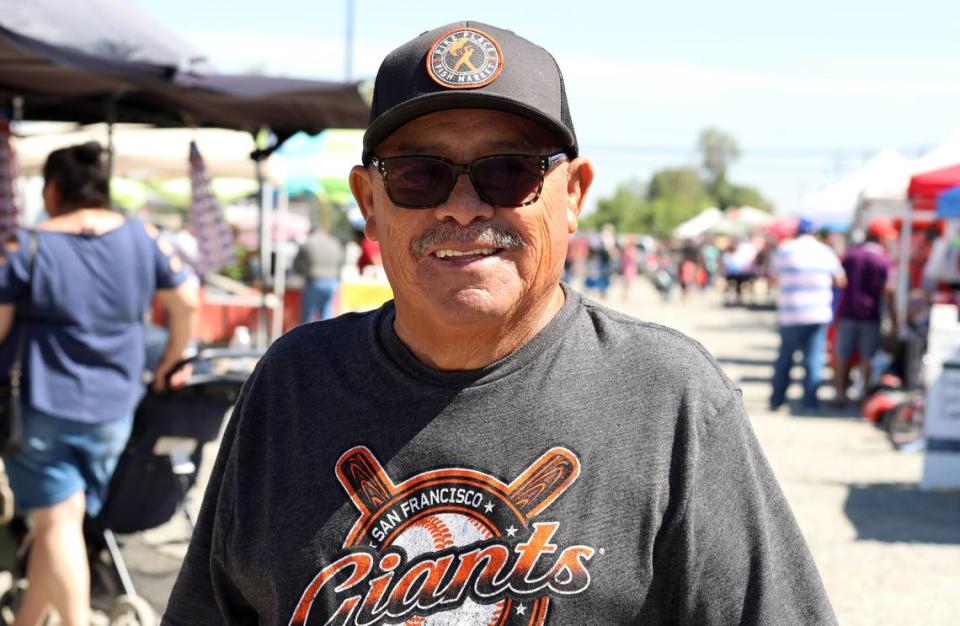Turnout in these California districts has been low for voters of color. Will 2024 change?
“I don’t really follow politics at all,” said Brandon Lopez, 29, of Lemoore.
Lopez, who does not have a party affiliation, told The Bee at Alma’s Flea Market in Hanford last month that he is registered to vote but he is not planning to vote in November.
Lopez feels both parties make promises but don’t deliver. He said he hasn’t been approached by any groups about voting, doesn’t know the name of his current congressman or who will be on the ballot in November.
Potential voters such as Lopez are crucial to the outcome of two congressional elections in the Central Valley, California’s 450-mile-long agricultural center. The elections are considered tossups by nonpartisan analysts.
The outcome of those elections in the San Joaquin Valley, the southern portion of the Central Valley, and other contests nearby could very well determine which political party controls Congress next year. Democrats only need to flip a handful of seats nationwide to win control while Republicans are hoping to hang on.
Many people said that they did not feel informed enough or did not care for politics as they declined to speak with The Bee. Many who did speak did not know the name of their congressman or who was on the 2024 ballot.
Tony Sanchez, 58, of Coalinga didn’t know who his congressman was. He said he may vote in November but that, regardless of party, he doesn’t “believe in politicians anymore.”
Veronica Soto, 36, of Lemoore said she used to vote in elections but not anymore. Soto, a Democrat, is not aware of who her current congressman is and doesn’t plan to vote in November.
“When it comes to like politicians, I feel like there’s a lot of things that are unseen, so it’s kind of a reason I stopped voting,” Soto said, “just because I feel like there’s a lot of hidden stuff.”
Voting groups are hoping to engage voters of color, who have historically tended to lean Democratic in California, although recent trends have indicated that Latino voters who are upset with politics in Sacramento and Washington D.C. are gravitating toward the GOP.
Both the valley congressional seats are now held by GOP congressmen. California’s 13th and 22nd Congressional Districts are Latino-majority voting districts with more registered Democrats than Republicans.
Each would have picked President Joe Biden over former President Donald Trump in 2020 by double-digit percentage points had current maps made through redistricting been in place.
Explaining issues that concern potential people of color, particularly people who have no-party preference, voter engagement groups say, could increase turnout in these districts and others.
“We overwhelmingly feel that Latino voters want our votes earned,” said Pablo Rodriguez, executive director of Communities for a New California Education Fund, which works on voter engagement. “The noise of advertising the political campaigns is not earning those votes.”
What are some efforts to engage minority voters?
Among the Democratic-leaning ventures is Battleground California, a Super PAC formed from more than a dozen voter-focused groups across the state.
It will aim to spend $15 million on eight races in the state where coalition leaders think voters of color and no-party preference voters could push Democratic candidates over the edge.
Super PACs can raise and spend money in unlimited amounts. While they can promote candidates, they can’t have any contact with their campaigns.
With a deadline for political groups to share fundraising and spending details next week, the effort’s progress will become clearer.
“If we can turn out our base of voters, especially more low propensity voters, then we can win these districts in comfortable margins,” said Jane Kim, the California Director for the Working Families Party, which helped form Battleground California, “and therefore win back the House.”
Groups that formed Battleground California are knocking on doors and calling people, analyzing what issues turn voters of color out and communicating on those issues, said Rodriguez.
Among the conservative efforts is the LIBRE Initiative Action, which recently held an event in June in a Hanford grocery store to highlight the effects of inflation, as affordability is a priority issue for Central Valley voters.
This is the first year that LIBRE is endorsing candidates in tough California races, including in the Central Valley, and is working to mobilize Latino voters there.
Polling from the LIBRE Institute, a separate entity from the initiative, found that Hispanic voters nationwide and in the Central Valley were not optimistic about the current trajectory of the country. One of LIBRE’s campaigns is Say No to Bidenomics.
LIBRE’s initiative is aiming to draw no-party-preference and moderate, flippable Democratic voters to Republican candidates.
“It’s fundamentally up to explaining to Latinos that they have to use their voice, that they have to be a part of the civic process, or they’re not going to have a seat at the table,” said Israel Ortega, a spokesman for the LIBRE Initiative.
Nonpartisan grassroots efforts are also engrossed in registering local voters. Many indicated that Latino voters, who make up the largest blocs in several Central Valley districts, felt abandoned and apathetic toward candidates.
Ivette Chaidez Villarreal, civic engagement program director for Valley Voices, spoke to The Bee and potential voters at Alma’s Flea Market in Hanford last month. Valley Voices is a nonpartisan nonprofit organization that promotes voting rights and bolsters registration in Kings, Tulare and Fresno counties.
“In my experience, interacting with Latinos in our area, they feel very disempowered. They feel like, no matter who they vote for, nothing ever changes, especially in our communities,” said Chaidez Villarreal.
One of the positive things she said she’s seen is that though there are many people that are apathetic, “we see a balance where there are folks that live in our community that even though they themselves aren’t eligible to vote for one reason or another, they take information for their siblings or their kids, their neighbors that are eligible to vote and try to get them as informed as possible.”

What are the close California congressional districts?
There are 10 congressional districts in California that nonpartisan analysts are watching closely. Several are toss-ups while in others the incumbents, whether a Republican or Democrat, are viewed as having some advantage.
Five races are in toss-up territory, looking at ratings from The Cook Political Report, Inside Elections, Sabato’s Crystal Ball and Elections Daily. All put House districts on a scale from “likely” to “leans” to “toss-up” for a party to win.
Two toss-ups are in the Central Valley: In California’s 13th, Rep. John Duarte, R-Modesto, and former Assemblyman Adam Gray, D-Merced, are on the ballot. In the 22nd, Rep. David Valadao, R-Hanford, and former Assemblyman Rudy Salas, D-Bakersfield, are competing.
Both are rematches from 2022 in districts in the San Joaquin Valley where voters picked Biden over Trump in 2020. Each tends to have low turnout compared to the rest of the state and each is a Latino-majority voting district, yet the San Joaquin Valley has never sent a Latino candidate to the House.
Low turnout, experts told The Bee, has led older, white, more conservative voters to have a bigger say in these districts even though large portions of the electorate there are younger, non-white or left-leaning.
Statewide polls indicate that the trend of low turnout for minority voters may continue in 2024. It’s still early in the election cycle and that could change. For instance, future polls could show whether Biden’s debate performance and rising calls for him to forgo the contest against Trump could affect congressional races.
Latino, Black and Asian American voters accounted for 30% of voters casting a primary ballot this year despite making up 47% of the state’s registered voters, according to a Public Policy Institute of California report released Tuesday.
Overall turnout and turnout for non-white voters tends to improve from the primary to the general election, and presidential election years tend to see more voters cast ballots. But it’s important to note that people of color are less likely to be registered to vote at all, wrote Eric McGhee, a PPIC policy director and senior fellow.
Research from the Center for Inclusive Democracy at the University of Southern California published in May found much higher campaign and informational outreach to frequent voters, who are more likely to be white, have higher incomes and be 65 or older. Nonpartisan voter outreach was under-resourced compared to the amount needed.
The survey indicated that turnout for Latino, Black and AAPI eligible voters would be far lower than white voters. Almost three-quarters of white voters responded with being “extremely likely” to vote — about 14 percentage points higher than AAPI voters, the next highest group to report being “extremely likely” to vote.
About 55% of Black voters and 52% of Latino voters responded they were “extremely likely” to vote.
“Historical and current barriers to voting for communities of color continue to have an impact at the ballot box,” said Mindy Romero, director of the Center for Inclusive Democracy who is the study’s lead author.
What did prospective voters of color say?

While many people felt ill informed on elections when The Bee approached them, some said they would definitely be voting.
Amanda Putnam, 32, of Turlock when interviewed at UC Merced last month, did not know the current congressional candidates but said she usually researches them about a month before. Leaning more Independent, she said she intends to vote in November.
“For me, I feel like you can’t complain about the current state of things if you’re not willing to do something about it,” Putnam said. “So for me, that’s voting.”
Elizabeth Rodriguez, 36, of Hanford is a Republican who said at Alma’s Flea Market that she was supporting Valadao and didn’t know who else was running. Rodriguez said she has not yet been approached by any groups to encourage her to vote.
She is planning on voting in November and has voted in other elections: “So, we can get more Republicans, so we can get more, the Democrats out,” she said.
Javier Avalos, 65, of Hanford, said he was undecided if he would be voting in the November election at the flea market.
“I don’t like any of them (candidates), especially (former president Donald) Trump, not that one,” said Avalos in Spanish.
Avalos, who is a naturalized U.S. citizen, said he has been registered to vote for the last three years but said he doesn’t have a party affiliation. When asked if he knew who his current congressman was, Avalos didn’t know who represented him and was not aware of the congressional candidates that would be on the ballot in November.

Desiree Ornelas, 20, when interviewed at UC Merced, did not know the congressional candidates running this year or her current congressman. She has been getting a lot of calls encouraging her to vote and plans to in November, but wants to learn about the candidates before deciding on who.
“I choose to vote because I do believe in the grander kind of scheme that every vote matters,” Ornelas said. “I think that in a democracy, it’s important for the people to vote.”
“It might not be the best system in the world, but it works,” Ornelas said. “It works for us in a kind of rough roundabout way, but it does work.”


